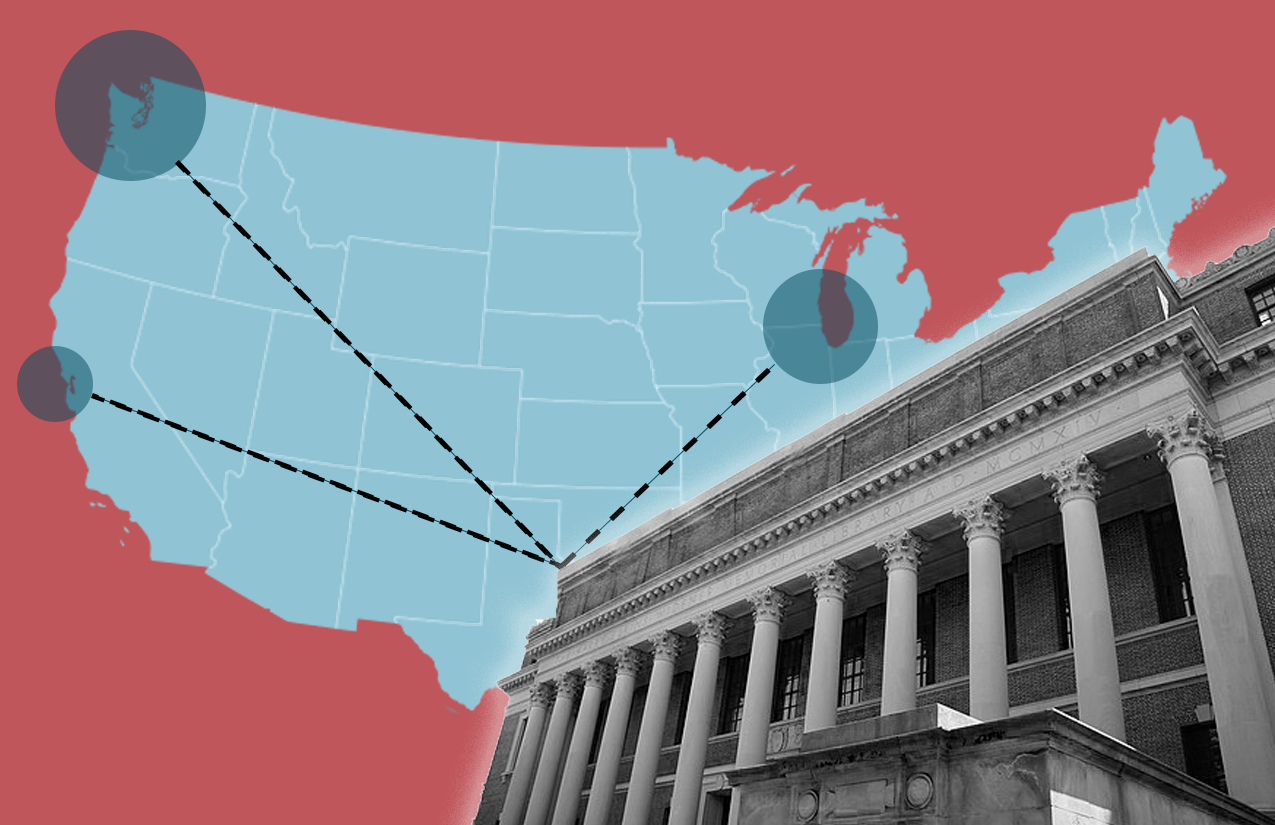Spending more on regional public universities with high graduation rates yields a high return on investment for states wishing to retain their college graduates.

Illustration by Kathleen Bolter; photograph by Jiaqian AirplaneFan via Wikimedia.
The stakes for understanding the social returns to funding of colleges have never been higher. Public funding of colleges has not recovered to its level from 20 years ago, and some states are currently trying to cut programs that leaders doubt will lead to high-paying in-state jobs. Unfortunately, policy discussions around the funding of public higher education often happen without policymakers knowing how colleges help students move up economically or where those college graduates end up working and living. Even though the government collects data on which states undergraduates at each college come from, there are no publicly available data for where graduates of specific colleges end up after graduation. This information is vital for local economic and workforce development and for estimating the state and local return on public funding of higher education. For example, should a county spend more on its community college if graduates often leave the area for places with more job opportunities? Or could that money be better used to create jobs? Similarly, if a state wants more residents to attain higher education, should it give more money to its top research university or to a regional university more focused on teaching?
New Data to Understand the Mobility of College Graduates
Of course, the data are not perfect. Not every college graduate creates a LinkedIn profile, and graduates occasionally stray from the truth when reporting the college(s) they attended. Thus, we check the quality of the data in several ways. For instance, we compare the school-specific alumni counts from LinkedIn with official graduate counts from the Department of Education’s Integrated Postsecondary Education Data System (IPEDS). The comparison shows a very high correlation between the two measures and implies that LinkedIn captures about two-thirds of all graduates. We also vet the data against an experimental Census Bureau data product, the Post-Secondary Employment Outcomes, which provides state location and earnings data for graduates from a limited number of colleges in certain states. Again, our data match up quite closely with the government data source. We can even show that overrepresentation of graduates from certain majors, such as business, in the LinkedIn data does not significantly alter the location patterns we calculate. Our paper provides many more details on the construction of the data.
Interested users can freely access the data on college graduate labor markets at OpenICPSR.
The Type of College Matters
From the data, we can learn many things that were previously unknown. For instance, the average recent college graduate moves approximately 200 miles away from his or her college. However, these distances vary considerably across different types of colleges, and not always in expected ways. Over a quarter of community colleges see their alumni spread out over wider geographic areas than the typical public university.
The share of alumni staying within the same metro area, or within the same state, varies across college sector, region of the country, and college selectivity. Although some of the patterns may not be surprising, we can measure them precisely for specific schools. For example, the University of Michigan (U-M), Eastern Michigan University (EMU), and Washtenaw Community College (WCC) are all located in the same county, but only 40 percent of U-M’s graduates stay within Michigan, while 76 percent of EMU’s alumni do, as do 80 percent of WCC’s alumni. Moreover, 71 percent of EMU’s graduates locate in greater Detroit, as do 75 percent of WCC alumni. For U-M graduates, only 35 percent remain in the greater Detroit area, with large contingents heading to New York City (10 percent), Chicago (7 percent), and the California Bay Area (6 percent).
Where college graduates decide to live after graduating has large implications for their economic mobility, particularly those from lower-income backgrounds. Our data reveal that a college student starting from the lowest income bracket has a higher chance of moving to the top income bracket in that student’s early career when the student’s college sends more of its graduates to places with strong labor markets and high wages. This connection between alumni locations and economic mobility persists even when accounting for detailed characteristics of the college (including its location) and its student body.
The Return on Investment for Retaining College Graduates
The labor markets that offer the greatest economic opportunity to graduates may be outside the local area or state that partly funds that college education. Consequently, some states may end up exporting many of their college graduates—resulting in a brain drain—while others import graduates educated in other states. Rural states are more likely to be net exporters, with more of their own college graduates leaving than students from outside the state flowing in. In contrast, states containing the bustling cities of Atlanta, Boston, Chicago, Denver, and Seattle import more graduates than their colleges produce.
We can combine the college-specific data on locations with government data on each college’s expenditures to calculate a crude estimate of the return on state funds for each public bachelor’s degree–granting college as the number of graduates retained in-state per $100,000 of state spending in appropriations and grants. On average, this return is 1.49, implying that about three graduates from the average college are produced and retained in-state for every $200,000 in state funds. The range, however, is considerable, with some colleges having a return of less than 1.00, while others have a return greater than 4.00. Interestingly, the return for state flagships, at 1.14, is substantially less than the return for moderately selective regional universities. Although the former have slightly higher graduation rates, they tend to cost more to educate graduates, who are also more likely to leave the state for farther-flung labor markets. Alumni of regional publics, especially those that have relatively high graduation rates, are more likely to stay and work close by, yielding a higher return on state funds. Considering that economic developers often view a job creation cost of $100,000 as reasonable, a public cost of roughly half that for an additional college-graduate worker seems like a steal.
Understanding where alumni of specific colleges work and live is critical for policymaking and economic development decisions. Our new dataset provides information on where each college’s graduates end up living and working after graduation, a hurdle many analysts have struggled to surmount, but which can now be used to answer questions from educators, policymakers, researchers, and students.
Policy Recommendation
• States should spend more money on regional public universities with high graduation rates. Doing so will yield a greater return on investment than most other job creation schemes, especially tax breaks for large employers.
Authors



